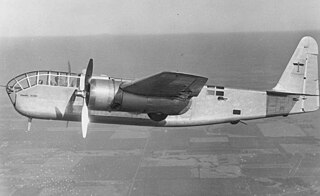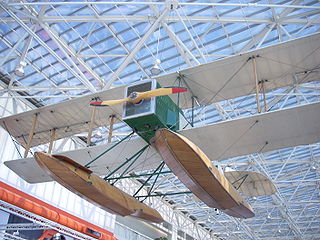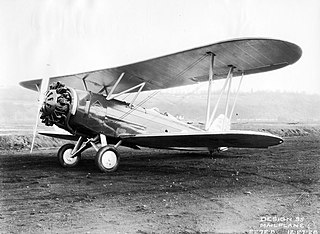
The Northrop C-19 Alpha was a series of three aircraft purchased from Northrop by the US Army Air Corps in 1931. They were slightly modified versions of the civil Northrop Alpha Type 2.

The Stearman XA-21 was a competitor in a United States Army Air Corps competition for a twin-engined attack aircraft which led to the Douglas A-20 Havoc, Martin A-22 Maryland and North American B-25 Mitchell.

The Boeing Model 1, also known as the B & W Seaplane, was a United States single-engine biplane seaplane aircraft. It was the first Boeing product and carried the initials of its designers, William Boeing and Lt. Conrad Westervelt USN.

The Boeing Model 95 was a single engine biplane mailplane built by Boeing in the United States in the late 1920s to supplement the Boeing Model 40s being used on Boeing's airmail routes.
The Bowers Namu II was a single-engine, two-seat, recreational aircraft, designed and flown in the United States in the late 1970s and marketed for homebuilding. It was designed by famed aircraft designer and Boeing historian Peter Bowers.
The Boeing Model 7, a.k.a. Boeing BB-1 was an American biplane flying boat aircraft built by Boeing in the 1920s. The pilot and two passengers all sat in the cockpit, the passengers right behind the pilot.
The Boeing Model 8, a.k.a. BB-L6, was an American biplane aircraft designed by Boeing specifically for their test pilot, Herb Munter.

The Boeing L-15 Scout or YL-15 was a small, piston engine liaison aircraft built by Boeing in small numbers after World War II. It was a short take-off and landing (STOL) aircraft powered by a 125 hp (93 kW) Lycoming engine. The L-15 intended by Boeing to expand its product line as World War II drew to a close, and Boeing's production of military aircraft declined. Boeing decided against marketing the L-15 as a general aviation aircraft, and the twelve produced went to the United States Army for testing, then were transferred to the United States Fish and Wildlife Service in Alaska for various duties.

The Manshū MT-1 Hayabusa was an airliner produced by the Japanese Manchuria Airplane Manufacturing Company in Manchukuo in the late 1930s. It was a conventional, low-wing cantilever monoplane with fixed tailwheel undercarriage. The flight deck was fully enclosed and separate from the passenger cabin, which could seat six people. The type equipped Manchukuo National Airways.

The Boeing Model 64 was an American single engine biplane training aircraft built by Boeing in the 1920s that failed to gain any orders.

The Boeing Model 6D, a.k.a. Boeing Model 6E, Boeing B-1D and Boeing B-1E, was an American pusher biplane flying-boat built by Boeing between 1928 and 1929.
The Boeing Model 42 was an American biplane aircraft developed from the Airco DH.4, taking advantage of the large number of aircraft left over after the end of World War I.

The Boeing Model 204 was an American biplane, pusher configuration flying-boat aircraft built by Boeing in 1929. Externally, the 204 looked identical to the Boeing Model 6E, but a number of internal changes, including increasing the passenger capacity to four, gave it a new type certificate and model number.

The Boeing Model 81 was an American training aircraft built by Boeing in 1928. The Model 81 was a development of the Model 64. It was powered by a newly developed engine, the 125 hp Fairchild-Caminez 4-cylinder radial engine. Operating at a much lower rpm than most engines it required the use of a large high-pitch propeller.

The Bushcaddy L-162 Max is a Canadian kit aircraft that was designed by Sean Gilmore and produced by Canadian Light Aircraft Sales and Service and most recently by Bushcaddy. The aircraft is supplied as a kit for amateur construction.
The Glassic SQ2000 is an American homebuilt aircraft, designed and produced by Glassic Composites LLC of Sale Creek, Tennessee. When it was available the aircraft was supplied as a kit for amateur construction.
The Las Brisas Mohawk is an American homebuilt aircraft that was designed and produced by Las Brisas Sales of Ozark, Missouri. When it was available the aircraft was supplied in the form of plans for amateur construction.
The Stern ST 87 Vega is a French homebuilt aircraft that was designed by Rene Stern, first flying in July 1992. The aircraft is supplied in the form of plans for amateur construction.
The Deland Travel Air 2000 is an American homebuilt aircraft that was designed and produced by Orlando Helicopter Airways, an aircraft maintenance and repair company located in DeLand, Florida. When it was available the aircraft was supplied as a kit for amateur construction and marketed under the "Deland" brand, named for the company's location. Plans were also available.
The Nihon L7P was a Japanese military seaplane built in World War II in the early 1940s.











